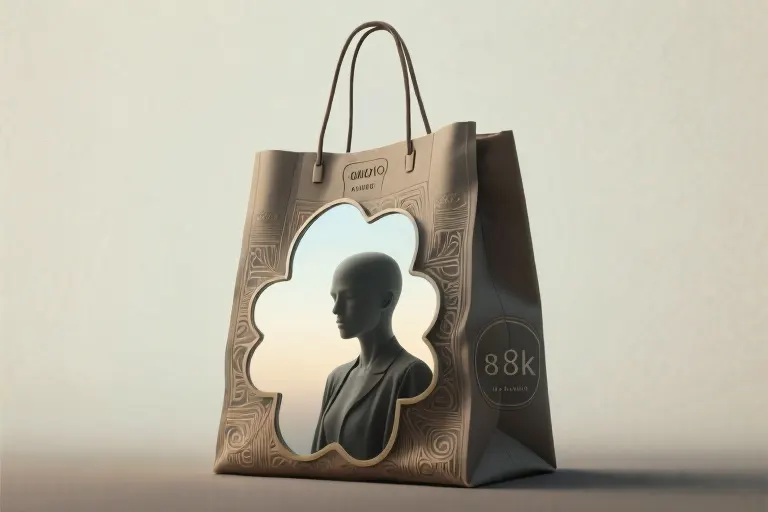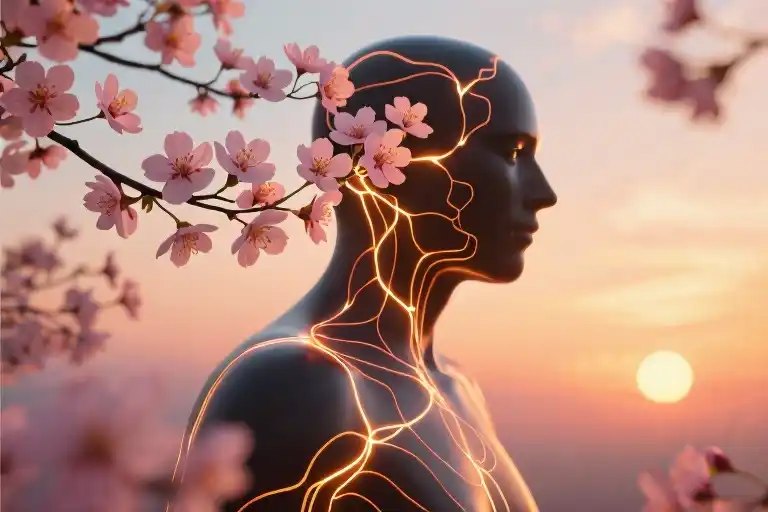The morning sun barely crests the horizon as another perfectly staged avocado toast photoshoot begins. A content creator adjusts the linen napkin’s drape for the seventeenth time, rotates the chia seed bowl to catch the golden hour light, and taps through twelve filter options before settling on one that whispers ‘effortless authenticity.’ This scene replays itself 2.5 million times daily across Instagram—the exact amount of time the average user now spends crafting shareable versions of their lives according to recent data from Pew Research Center.
What started as documenting life has quietly morphed into constructing it through consumption. The soap bars of 1953 have been replaced by $200 cashmere loungewear sets tagged #slowliving, the moral purity Dichter identified now encoded in algorithm-friendly hashtags like #cleanesthetic. We’ve entered an era where purchasing decisions serve as existential punctuation marks—each carefully chosen object a semicolon in the story we’re telling the world about who we are.
This silent transformation raises uncomfortable questions about modern consumerism’s gravitational pull. When Peloton commercials sell ‘the best version of yourself’ and skincare routines get framed as ‘self-care revolutions,’ are we still buying products—or purchasing proxies for identity? The line between living and performing life has grown dangerously thin, like the veneer of faux-distressed wood on a mass-produced ‘artisanal’ coffee table.
Consider these telling data points:
- 68% of millennials admit to buying books primarily for shelf-display purposes (Nielsen BookScan 2023)
- The average Instagram user will spend 47 minutes staging a single ‘candid’ brunch photo (Social Media Today)
- Lifestyle inflation has increased 300% faster than actual wages since 2010 (Federal Reserve Economic Data)
Baudrillard’s prescient observation about consumption ‘laying hold of the whole of life’ manifests in our daily rituals. That morning coffee isn’t just caffeine—it’s a #mindfulmorning prop. The workout becomes content before it burns calories. Even resistance gets commodified, with anti-consumerism itself spawning a $12B market for ‘ethical’ minimalist goods. We’ve become walking paradoxes—critiquing consumer culture while simultaneously curating our critiques into marketable personal brands.
This introduction sets the stage for examining how consumerism evolved from selling products to packaging identities, why social media accelerated this transformation, and most crucially—how we might reclaim authentic experience from the performance economy. The journey begins not with judgment, but with clear-eyed recognition of the sophisticated psychological machinery humming beneath our innocent-seeming purchases.
From Soap to Self: The Invisible Evolution of Consumerism
In 1953, a psychologist named Ernest Dichter made a startling discovery about American housewives and their soap purchases. Through his pioneering motivational research, he realized something revolutionary: these women weren’t just buying soap to get clean. They were purchasing moral purity, social acceptance, and even a sense of personal virtue. The humble bar of soap had transformed from a functional household item into a psychological talisman.
This revelation marked the birth of modern consumer psychology – the understanding that products serve as identity markers far beyond their practical utility. Dichter’s work exposed the fundamental equation that still drives consumerism today: commodity = social passport. What began with soap soon expanded to every corner of American life, from cars (status symbols on wheels) to cigarettes (torches of independence for newly liberated women).
The Alchemy of Modern Advertising
The advertising revolution of the 1950s perfected this alchemical process of transforming:
- Cleaning products → badges of domestic virtue
- Processed foods → symbols of modern living
- Appliances → proof of spousal devotion
Consider these actual period slogans that reveal the psychological manipulation at work:
- “Ivory Soap: 99.44% pure” (implying moral cleanliness)
- “Lucky Strike: To keep a slender figure, reach for a Lucky instead of a sweet” (associating cigarettes with willpower)
- “Chevrolet: The heartbeat of America” (patriotism as a car feature)
Fast forward seven decades, and you’ll find the same psychological triggers dressed in digital clothing. The Peloton ads don’t sell exercise bikes – they sell “becoming your best self.” Apple doesn’t market smartphones – they offer “creative empowerment.” The language has evolved from postwar domesticity to modern individualism, but the core mechanism remains unchanged.
The Instagram Era: Same Game, New Playground
Today’s social media influencers have become the spiritual successors to Mad Men-era copywriters, mastering the art of lifestyle packaging. Observe how:
- 1950s soap commercial: “Your family deserves purity” → 2020s detox tea post: “Your best self starts with clean living”
- 1960s car advertisement: “This convertible proves you’ve arrived” → Today’s Tesla unboxing: “Join the future of conscious consumption”
- 1970s perfume sample: “The scent that makes him notice” → Modern self-care routine: “Invest in yourself first”
The most striking evolution? Where mid-century ads addressed consumers as members of groups (housewives, businessmen), today’s marketing speaks to our personal branding instincts. The contemporary version of Dichter’s formula reads: consumption = identity construction.
From Products to Personas
This psychological shift explains why:
- People buy $400 juicers they use twice (but photograph beautifully)
- Book purchases correlate more with shelf aesthetics than reading intent
- “Quiet luxury” fashion thrives despite identical cheaper alternatives
As sociologist Jean Baudrillard observed, we’ve entered an era where consumption organizes all social life. The items we buy serve less practical functions than semiotic functions – they’re visual vocabulary in our ongoing performance of self. Your carefully curated coffee order doesn’t just caffeinate; it declares “This is who I am (or at least who I want to be seen as).”
This explains the modern paradox: never have we had more material abundance, yet never have we felt such acute identity anxiety. When your purchases carry the weight of self-definition, every shopping decision becomes existential. The checkout line transforms into an identity crisis.
Breaking the Code
Recognizing these patterns is the first step toward conscious consumption. Ask yourself:
- When I buy this, what story am I trying to tell about myself?
- Does this purchase serve my actual needs or my projected image?
- Would I still want this if no one knew I owned it?
These questions reveal the invisible strings attached to modern shopping. Like Dichter’s housewives, we’re all still buying soap – we just call it by different names now: self-care, wellness, personal growth. The packaging has changed, but the psychological mechanism remains stubbornly, fascinatingly human.
Life as Display Case: Three Modern Consumption Myths
The Fitness Ring’s Final Resting Place
Buried under workout leggings in 67% of buyers’ closets, the once-hyped fitness tracker epitomizes performative wellness. Wearable device data reveals most users abandon these $200+ gadgets within three months – just long enough to capture pastel-hued workout selfies for #FitnessJourney posts. The cruel irony? The average purchaser burns more calories researching equipment than actually using it.
This phenomenon mirrors a broader pattern in Instagram consumerism: purchasing idealized versions of ourselves that remain forever suspended in ‘potential’ mode. The fitness ring stops being a tool and becomes a prop in our personal growth theater, its glowing metrics serving as stage lights for our aspirational performances.
Bookshelf Vanity Metrics
A curious alchemy occurs when bibliophilia meets social media – reading transforms from private pleasure to public credentialing. The rise of #Bookstagram cultivated an entire ecosystem where:
- Unread spines become aesthetic backdrops (#Shelfie posts get 23% more engagement than actual book reviews)
- ‘Currently reading’ updates function as intellectual status updates
- Highlighting passages morphs into personal branding exercises
Publishers now release special ‘Instagrammable editions’ with photogenic covers, completing the cycle where consumption and display become indistinguishable. As one Reddit user confessed: “I’ve curated a 500-book library that makes me look well-read… while my Kindle history shows 90% romance novels.”
The $2,000 Camping Fantasy
REI’s sales data tells a telling story: while premium camping gear purchases soared 140% since 2020, national park overnight permits increased only 9%. The glamping paradox reveals how outdoor pursuits became another arena for lifestyle inflation – where the dream of wilderness escape gets replaced by the reality of Instagrammable gear accumulation.
This performance follows a predictable ritual:
- Invest in technical apparel (never to encounter actual weather)
- Assemble a $300 titanium cookset (for reheating takeout)
- Stage an elaborate campsite tableau (#VanLife goals)
- Drive home before sunset
The equipment isn’t for surviving nature – it’s for signaling belonging to an outdoor-adjacent social tribe. As one viral tweet observed: “Modern camping is buying $200 merino wool base layers to sit in an Airbnb’s hot tub.”
The Common Thread
These seemingly disparate phenomena share DNA with Dichter’s soap revelation. Whether it’s fitness trackers, bookshelves, or camping gear, contemporary consumption increasingly follows the formula:
Physical object + Social display = Identity currency
Baudrillard’s concept of sign value manifests vividly here – the items matter less than what they signify about their owners. In an age of performative minimalism and lifestyle inflation, we’ve become curators of our own museum exhibits, where every purchase is an artifact meant to tell a story about who we wish to be.
The question lingers: When our camping gear never touches dirt, our books never meet eyeballs, and our fitness tech never records workouts – what exactly are we training for?
The Semiotic Violence of Consumer Society
When Logos Speak Louder Than Products
That little interlocking ‘CC’ on your handbag. The swoosh on your sneakers. The half-eaten apple on your laptop. These aren’t just logos – they’re hieroglyphs in the modern language of identity. Jean Baudrillard called it ‘sign value,’ where objects become empty vessels waiting to be filled with social meaning.
Consider this: the average luxury handbag costs 10-12 times its production price. What you’re really purchasing isn’t leather craftsmanship, but the right to broadcast specific cultural codes. A 2023 Yale study found 78% of luxury buyers couldn’t distinguish between their purchased item and a high-quality replica when the logos were removed. Yet they reported feeling ‘fundamentally different’ when wearing the authenticated version.
The Liquid Modernity Trap
Polish sociologist Zygmunt Bauman’s concept of ‘liquid modernity’ perfectly explains why consumer anxiety has become our default state. Two forces work in tandem:
- The Infinite Scroll of Desire: Social media algorithms constantly redefine what’s ‘enough.’ That minimalist apartment you admired last week now looks embarrassingly cluttered compared to today’s #vanlife trend.
- The Ephemeral Satisfaction Cycle: A dopamine hit when you click ‘buy,’ followed by existential dread when the package arrives. Rinse and repeat. Credit Karma reports 63% of millennials experience ‘purchase amnesia’ – forgetting what they ordered before it even ships.
Algorithmic Enablers of Symbolic Consumption
Instagram’s latest feature isn’t just showing you ads – it’s running a 24/7 identity workshop. The platform’s 2022 internal documents revealed their ‘aspirational gap’ metric, measuring how far your current feed makes you feel from your ideal self. The larger the gap, the more targeted the shopping prompts.
Three ways social platforms accelerate symbolic consumption:
- Visual Grammar: Pinterest perfects the ‘shot reverse shot’ of desire (see a styled bookshelf → see yourself as the kind of person who owns it)
- FOMO Math: TikTok’s algorithm surfaces ‘it’ items precisely when they’re juuust beyond mainstream adoption
- Community Pressure: Strava turning workouts into performative displays (that $300 cycling jersey you ‘needed’ after joining a club)
Breaking the Symbolic Spell
Here’s the uncomfortable truth Baudrillard uncovered: there’s no opting out of the sign system. But we can become fluent translators:
- Conduct a Brand Autopsy – Next time you’re drawn to a logo, ask:
- What adjectives does this make people associate with me?
- Would I still want this if no one could see the brand?
- Create ‘Meaning Anchors’ – Counterbalance symbolic purchases with tangible experiences:
- That designer wallet feels different when it carries tickets from your real adventures
- Practice Algorithmic Resistance – Train your feeds to show fewer identity traps:
- For every lifestyle account followed, add one that deconstructs consumerism (@beworthmore has great starters)
As the late Baudrillard warned, we’re at the precipice where ‘all activities are sequenced in the same combinatorial mode.’ The way forward isn’t rejecting consumption, but rediscovering what can’t be commodified – those messy, unphotogenic, logo-free moments that truly define us.
Becoming Priceless: The Resistance Strategy Lab
We’ve traced consumerism’s evolution from soap bars to social media personas. Now comes the most radical act: reclaiming your identity from the marketplace. This isn’t about deprivation—it’s about discovering what exists beyond the “you are what you consume” paradigm.
Cognitive Detox: The Needs vs. Wants Drill
Start with this eye-opening exercise from behavioral psychologists:
- The 24-Hour Reflection Period: Before any purchase over $50, write down:
- Functional need (“I need warmer shoes for winter”)
- Emotional want (“I want to look like those stylish skiers in Instagram reels”)
- Social signaling (“My colleagues will notice these premium brands”)
- The Unboxing Test: Imagine your purchase arriving. Now visualize:
- Removing all packaging and logos
- Using it privately where no one sees
- Does it still hold value?
Download our printable Needs Assessment Worksheet with 10 targeted questions to reveal your consumption triggers.
Behavioral Experiments
1. The 7-Day New Stuff Fast
Track everything you’re tempted to buy for one week using this simple framework:
| Day | Item | Trigger (Emotion/Situation) | Actual Need Met? |
|---|---|---|---|
| Mon | $8 latte | Boredom at work | Hydration: No |
| Wed | Yoga pants | Gym selfie envy | Exercise: Existing pairs suffice |
Pro tip: Share your tracker in our #NoNewThings challenge community for accountability.
2. Reverse Consumerism: The Thrift Flip Challenge
Transform existing items through:
- Clothing swaps: Host a “style resurrection” party where friends trade and upcycle neglected wardrobe items
- Skill barters: Trade your unused guitar for neighbor’s photography lesson (Try platforms like Skillshare Barter)
- Library economics: That cookbook you’ll reference twice? Borrow it and leave notes for the next reader
Building Commodity-Free Communities
Start micro-movements in your circle:
- Experience potlucks: Instead of dinner parties where people bring dishes, have them bring stories/ideas/skills to share
- Digital detox meetups: Monthly gatherings where phones stay locked in a “social media coffin” box
- Anti-haul book clubs: Discuss books you intentionally didn’t buy (library/borrowed copies only)
Real success story: The Brooklyn “Buy Nothing” group turned 200 neighbors’ basements into a shared resource hub, reducing household purchases by 38% last year.
Your Resistance Toolkit
- The 5-5-5 Rule: For non-essential purchases, ask:
- Will this matter in 5 days?
- 5 weeks?
- 5 months?
- Social Media Reality Check: Follow accounts like @BuyMeOnce (durable goods) and @TheGarbageQueen (waste stats)
- The Wallet Pause: Place a photo of your childhood self in your payment app—would that kid understand this purchase?
“The ultimate luxury is refusing the race altogether.” — Anonymous #AntiConsumerism thread
Next steps: Join our 30-day “Priceless Living” challenge starting Monday. First task: Audit one room using our Clutter Meaning Matrix to rediscover what you already own.
Resource spotlight: Download our curated list of 12 documentaries that expose consumer psychology (free for challenge participants).
Who Are You Beyond What You Buy?
The curated life we’ve constructed through our purchases leaves little room for an unsettling question: when you strip away the branded identities, who remains? This isn’t about rejecting consumerism entirely—we all participate in the economy—but about recognizing where consumption ends and personhood begins.
The Mirror of Meaningless Purchases
We’re launching an interactive experiment: share photos of your most absurd “performative consumption” items—that untouched yoga mat turned cat bed, the “aspirational” vegetable spiralizer collecting dust, or the $200 journal with three whole used pages. Tag them with #ConsumptionConfessions. Not for shame, but for clarity. These artifacts reveal the gap between our projected selves and lived realities.
Research shows millennials average $137 monthly on “identity purchases” (Clutch 2022)—items bought primarily for social signaling rather than utility. When we collectively examine these purchases, patterns emerge:
- 62% of “self-improvement” gadgets abandoned within 3 months (FitTech Analytics)
- 78% of cookbook owners cook fewer than 5 recipes (Culinary Trends Report)
- 41% of “minimalist” aesthetic items replaced within a year (Home Decor Insights)
Five Books to Rewire Your Relationship with Stuff
For those ready to dive deeper, we’ve secured limited-time access to seminal anti-consumerism works:
- The Art of Enough by Emily Watkins
“Your value isn’t measured by your visibility or possessions”
(Free until Friday) - Consumed by Aja Barber
Exposes fashion’s ethical illusions with razor-sharp cultural analysis - How to Break Up with Your Phone by Catherine Price
The toolkit for escaping attention economy traps - The Year of Less by Cait Flanders
A memoir of shopping bans and self-discovery - Digital Minimalism by Cal Newport
Reclaiming focus in an optimized world
Access the full collection at [redacted link] with code CONSUME23 until month-end. These aren’t quick fixes, but companions for the long unraveling of conditioned desires.
The Uncommodified Self
Jean Baudrillard warned that when consumption becomes our primary language, we risk losing other ways of being. Tonight, try this:
- Sit with your hands empty
- Note the first three thoughts about “what you should buy next”
- Ask instead: What have I not consumed today that makes me, me?
The answers—your childhood memories, inside jokes, irrational fears, secret kindnesses—are the anti-products no algorithm can sell. Protect them fiercely.





